History
In the later division of the Roman Empire under the Emperor Diocletian, the eastern part of Mauretania Caesariensis, from Saldae to the river Ampsaga, was split into a new province, and called Mauretania Sitifensis named after the inland town of Setifis (Setif in modern Algeria). [2]
At the time of Constantine the Great, Mauretania Sitifensis was assigned to the administrative Diocese of Africa, under the Praetorian prefecture of Italy. The new province had a huge economic development in the 4th century, until the conquest by the Vandals. In this province, the Christian denomination known as Donatism challenged the Roman Church (which was the main local religion after Constantine), while Setifis was a center of Mithraism. [3]
After the fall of the Western Roman Empire, certain areas of Mauretania Sitifensis were under Vandal and later Byzantine control, but most of the province (until 578 AD) was ruled by Berber kingdoms like the Kingdom of Altava. Only the coastal area around Saldae and Setifis remained fully Romanized.
Byzantine emperor Maurice in 585 AD created the province of Mauretania Prima and erased the old Mauretania Sitifensis. Indeed, the emperor Maurice in that year created the office of "Exarch", which combined the supreme civil authority of a praetorian prefect and the military authority of a magister militum , and enjoyed considerable autonomy from Constantinople. Two exarchates were established, one in [taly, with seat at Ravenna (hence known as the Exarchate of Ravenna), and one in Africa, based at Carthage and including all imperial possessions in the Western Mediterranean. The first African exarch was the Patricius Gennadius: he was appointed as magister militum Africae in 578 AD, and quickly defeated the Romano-Moorish kingdom of Garmul in Mauretania extending the territory of the Mauretania Sitifensis. Among the provincial changes done by emperor Maurice, Mauretania Caesariensis and Mauretania Sitifensis were re-merged as a province of Mauretania Prima.
Mauretania Sitifensis initially had an area of 17800 square miles and had a good agriculture (cereals, etc..), that was exported through the port of Saldae. [4] But under Byzantine control the province was reduced to only the coastal section, with one third of the original area.
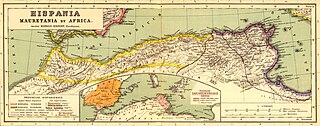
Mauretania is the Latin name for a region in the ancient Maghreb. It extended from central present-day Algeria to the Atlantic, encompassing northern present-day Morocco, and from the Mediterranean in the north to the Atlas Mountains. Its native inhabitants, of Berber ancestry, were known to the Romans as the Mauri and the Masaesyli.
Parthenia was a Roman–Berber town in the former Roman province of Mauretania Sitifensis, the easternmost part of ancient Mauretania. It was located in what is now northern Algeria.
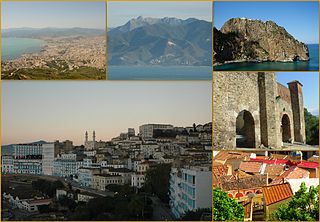
Béjaïa formerly Bougie and Bugia, is a Mediterranean port city and commune on the Gulf of Béjaïa in Algeria; it is the capital of Béjaïa Province, Kabylia. Béjaïa is the largest principally Kabyle-speaking city in the region of Kabylia, Algeria.

The Exarchate of Africa was a division of the Byzantine Empire around Carthage that encompassed its possessions on the Western Mediterranean. Ruled by an exarch (viceroy), it was established by the Emperor Maurice in 591 and survived until the Muslim conquest of the Maghreb in the late 7th century. It was, along with the Exarchate of Ravenna, one of two exarchates established following the western reconquests under Emperor Justinian I to administer the territories more effectively.

Mauretania Caesariensis was a Roman province located in present-day Algeria. The full name refers to its capital Caesarea Mauretaniae.
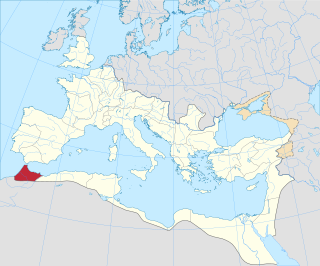
Mauretania Tingitana was a Roman province, coinciding roughly with the northern part of present-day Morocco. The territory stretched from the northern peninsula opposite Gibraltar, to Sala Colonia and Volubilis to the south, and as far east as the Mulucha river. Its capital city was Tingis, which is the modern Tangier. Other major cities of the province were Iulia Valentia Banasa, Septem, Rusadir, Lixus and Tamuda.

Saldae was an important port city in the ancient Roman Empire, located at today's Béjaïa. It was generally a crossroads between eastern and western segments of Northern Africa, from the time of Carthage to the end of the Byzantine Empire from the continent.

Zaraï was a Berber, Carthaginian, and Roman town at the site of present-day Aïn Oulmene, Algeria. Under the Romans, it formed part of the province of Numidia.

Sétif is the capital city of the Sétif Province and the 5th most populous city of Algeria, with an estimated population of 410,000 residents in 2015 in an area of more than 127 km2. It is one of the most important cities of eastern Algeria and the country as a whole, since it is considered the trade capital of the country and an industrial pole with 3 industrial zones within the borders of the city.
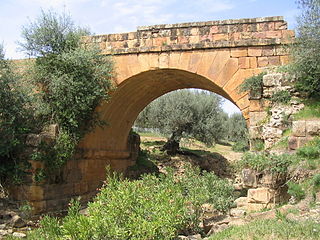
Thuburnica was an ancient Roman-Berber city in the Maghreb. It was located in the present-day El Kalâa, near Chemtou in western Tunisia. It may have been the ancient town of Bulla Regia.

The Praetorian Prefecture of Africa was an administrative division of the Byzantine Empire in the Maghreb. With its seat at Carthage, it was established after the reconquest of northwestern Africa from the Vandals in 533–534 by the Byzantine Emperor Justinian I. It continued to exist until 591, when it was replaced by the Exarchate of Africa.

Igilgili was a Berber town and a Phoenician, Carthaginian, and Roman colony in located in present-day Jijel, Algeria.

Byzantine rule in North Africa spanned around 175 years. It began in the years 533/534 with the reconquest of territory formerly belonging to the Western Roman Empire by the Eastern Roman (Byzantine) Empire under Justinian I and ended during the reign of Justinian II with the conquest of Carthage (698) and the last Byzantine outposts, especially Septem (708/711), in the course of Islamic expansion.
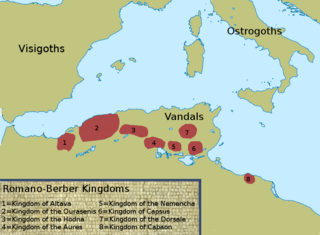
The Kingdom of Altava was an independent Christian Berber kingdom centered on the city of Altava in present-day northern Algeria. The Kingdom of Altava was a successor state of the previous Mauro-Roman Kingdom which had controlled much of the ancient Roman province of Mauretania Caesariensis. During the reign of Kusaila, it extended from Volubilis in the west to the Aurès and later Kairaouan and the interior of Ifriqiya in the east. This Kingdom collapsed following Eastern Roman military campaigns to decrease its influence and power after Garmul invaded the Exarchate of Africa.

Sétifis, was a Roman town located in northeastern Algeria. It was the capital of the Roman province called Mauretania Sitifensis, and it is today Setif in the Sétif Province (Algeria).

Tubusuctu also known as Colonia Iulia Augusta Legionis VII, was a Roman colony founded by Augustus for military veterans and known for its olive oil.
Aquae Calidae was a Roman colony of the Roman province of Mauretania Caesariensis. The Roman city has been identified with ruins at Hammam Righa in the wilaya of Chlef, Algeria, North Africa.
The Limes Mauretaniae was a portion of a 4,000-kilometre (2,500 mi) Roman fortified border (limes) in Africa approximately 100 kilometres (62 mi) south of the modern day Algiers.
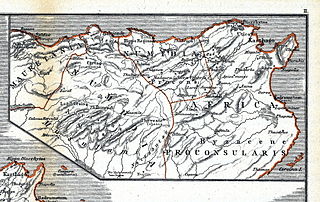
Numidia was a Roman province on the North African coast, comprising roughly the territory of north-east Algeria.

The Mauro-Roman kingdom, also described as the kingdom of Masuna, was a Christian Berber kingdom which dominated much of the ancient Roman province of Mauretania Caesariensis from the capital city of Altava. Scholars are in disagreement about whether the polity aimed for independence as a kingdom or was part of a loose confederation, an alternative hypothesis drawn from contextual knowledge about Berber tribal alliances. In the fifth century, Roman control over the province weakened and Imperial resources had to be concentrated elsewhere, notably in defending the Roman Italy itself from invading Germanic tribes. Moors and Romans in Mauretania came to operate independently from the Empire. However, regional leaders may not have necessarily felt abandoned by the Romans.

















